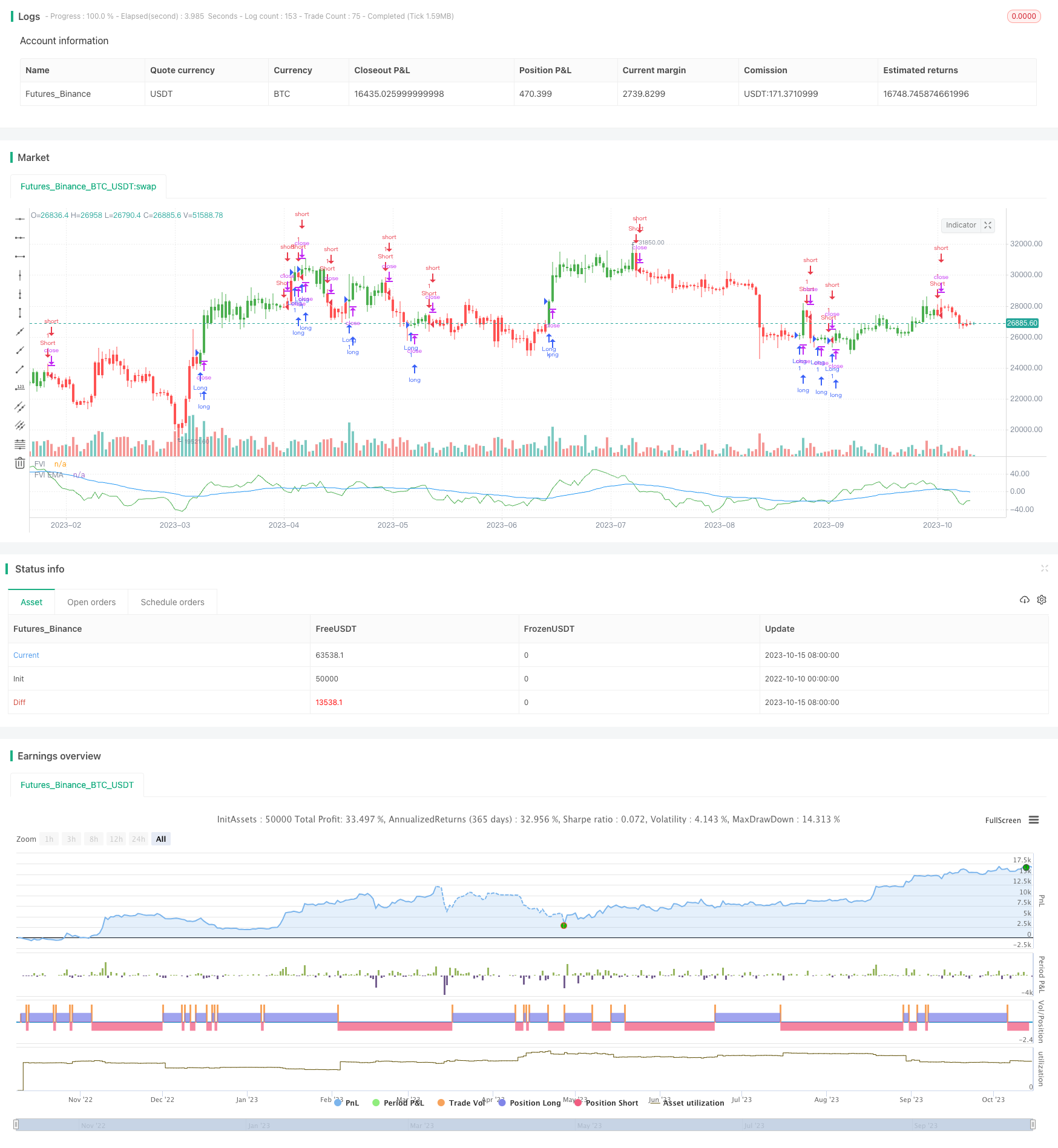
概述
本策略利用有限体积要素方法,结合自适应波动性计量,对价格变化进行多空判断,属于趋势跟踪类策略。策略适用于各个时间周期,能够自动调整参数,适应不同波动性水平。
原理
策略先计算最近N根K线的高低平均价、收盘价平均价,以及前一根K线的高低收盘价平均价。然后计算当前K线和前一K线的对数收益率 Intra 和 Inter。同时计算 Intra 和 Inter 的波动性 Vintra 和 Vinter。
根据波动性水平和可调参数,计算自适应截断系数 CutOff。当价格变化超过 CutOff 时,给出多空信号。具体来说,计算当前K线收盘价与高低平均价的差值 MF,当 MF 大于 CutOff 时为多头信号,当 MF 小于负的 CutOff 时为空头信号。
最后根据信号计算资金流向, outputs 信号 pos,并画出有限体积要素曲线 FVE。
优势
- 自适应参数,适用于不同周期和波动性水平,无需人为调整。
- 准确捕捉价格趋势变化。
- 有限体积要素曲线清晰反映多空力量对比。
- 资金流理论基础稳固,信号比较可靠。
风险
- 市场剧烈震荡时,可能出现较多错误信号。可以适当调整 N 参数。
- 无法处理价格跳空。可以考虑补充其他指标进行组合。
- 资金流理论与技术分析信号可能存在背离。可以考虑多种信号综合判断。
优化方向
- 可以测试不同 N 参数对结果的影响。一般 N 取较大值,能够过滤掉过多噪声。
- 可以测试 Cintra 和 Cinter 的不同取值,找到最佳参数组合。也可以考虑动态调整这两个参数。
- 可以考虑与其他指标如 MACD 等组合,提高策略稳定性。
- 可以建立止损机制,以控制单笔损失。
总结
本策略整体来说较为可靠,原理优良,可以作为趋势跟踪策略的组成部分,与其他策略适当组合后效果会更好。关键是找到最佳参数,并建立良好的风控措施。如果后期能够继续优化,会成为非常强大的趋势跟踪策略。
策略源码
/*backtest
start: 2022-10-10 00:00:00
end: 2023-10-16 00:00:00
period: 1d
basePeriod: 1h
exchanges: [{"eid":"Futures_Binance","currency":"BTC_USDT"}]
*/
//@version=2
////////////////////////////////////////////////////////////
// Copyright by HPotter v1.0 18/08/2017
// This is another version of FVE indicator that we have posted earlier
// in this forum.
// This version has an important enhancement to the previous one that`s
// especially useful with intraday minute charts.
// Due to the volatility had not been taken into account to avoid the extra
// complication in the formula, the previous formula has some drawbacks:
// The main drawback is that the constant cutoff coefficient will overestimate
// price changes in minute charts and underestimate corresponding changes in
// weekly or monthly charts.
// And now the indicator uses adaptive cutoff coefficient which will adjust to
// all time frames automatically.
//
// You can change long to short in the Input Settings
// Please, use it only for learning or paper trading. Do not for real trading.
////////////////////////////////////////////////////////////
strategy(title="Volatility Finite Volume Elements", shorttitle="FVI")
Samples = input(22, minval=1)
Perma = input(40, minval=1)
Cintra = input(0.1, step=0.1)
Cinter = input(0.1, step=0.1)
reverse = input(false, title="Trade reverse")
xhl2 = hl2
xhlc3 = hlc3
xClose = close
xIntra = log(high) - log(low)
xInter = log(xhlc3) - log(xhlc3[1])
xStDevIntra = stdev(sma(xIntra, Samples) , Samples)
xStDevInter = stdev(sma(xInter, Samples) , Samples)
xVolume = volume
TP = xhlc3
TP1 = xhlc3[1]
Intra = xIntra
Vintra = xStDevIntra
Inter = xInter
Vinter = xStDevInter
CutOff = Cintra * Vintra + Cinter * Vinter
MF = xClose - xhl2 + TP - TP1
FveFactor = iff(MF > CutOff * xClose, 1,
iff(MF < -1 * CutOff * xClose, -1, 0))
xVolumePlusMinus = xVolume * FveFactor
Fvesum = sum(xVolumePlusMinus, Samples)
VolSum = sum(xVolume, Samples)
xFVE = (Fvesum / VolSum) * 100
xEMAFVE = ema(xFVE, Perma)
pos = iff(xFVE > xEMAFVE, 1,
iff(xFVE < xEMAFVE, -1, nz(pos[1], 0)))
possig = iff(reverse and pos == 1, -1,
iff(reverse and pos == -1, 1, pos))
if (possig == 1)
strategy.entry("Long", strategy.long)
if (possig == -1)
strategy.entry("Short", strategy.short)
barcolor(possig == -1 ? red: possig == 1 ? green : blue )
plot(xFVE, color=green, title="FVI")
plot(xEMAFVE, color=blue, title="FVI EMA")